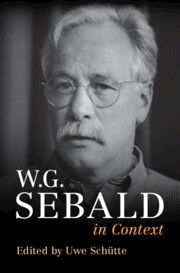Book contents
- W.G. Sebald in Context
- W.G. Sebald in Context
- Copyright page
- Dedication
- Contents
- Illustrations
- Notes on Contributors
- Preface
- Acknowledgements
- Note on Text
- Chronology
- Abbreviations
- Works by W.G. Sebald
- Part I Biographical Aspects
- Part II The Literary Works
- Chapter 8 Unpublished Juvenilia
- Chapter 9 Film Scripts
- Chapter 10 The Prose Project
- Chapter 11 Auto-/Biography
- Chapter 12 Natural History and the Anthropocene
- Chapter 13 The Corsica Project
- Chapter 14 Poetry
- Chapter 15 The World War Project
- Chapter 16 Interviews
- Part III Themes and Influences
- Part IV Reception and Legacy
- Further Reading
- Index
Chapter 15 - The World War Project
from Part II - The Literary Works
Published online by Cambridge University Press: 24 August 2023
- W.G. Sebald in Context
- W.G. Sebald in Context
- Copyright page
- Dedication
- Contents
- Illustrations
- Notes on Contributors
- Preface
- Acknowledgements
- Note on Text
- Chronology
- Abbreviations
- Works by W.G. Sebald
- Part I Biographical Aspects
- Part II The Literary Works
- Chapter 8 Unpublished Juvenilia
- Chapter 9 Film Scripts
- Chapter 10 The Prose Project
- Chapter 11 Auto-/Biography
- Chapter 12 Natural History and the Anthropocene
- Chapter 13 The Corsica Project
- Chapter 14 Poetry
- Chapter 15 The World War Project
- Chapter 16 Interviews
- Part III Themes and Influences
- Part IV Reception and Legacy
- Further Reading
- Index
Summary
Shortly after completing the manuscript of Austerlitz in the year 2000, W.G. Sebald was awarded a NESTA Fellowship in order to research his next book, which he referred to as the ‘W. W.’ (World War) Project. His grant application refers to ‘an extensive narrative which will encompass the period 1900-1950’. Over the next eighteen months he visited France and Germany several times in order to visit sites, archives and people. This essay examines Sebald’s plans for the project as well as interviews and recollections from the time, including reflections on his own family history and his late schoolfriend, Barbara Aenderl. It considers how the finished book might have developed the more traditional approach to narrative evident in Austerlitz, culminating in a comparison with Tolstoy’s War and Peace, a text which also combines fiction, history and critical reflection. Through considering both Tolstoy’s view of history and Isaiah Berlin’s famous essay on the subject, it suggests that Sebald’s unfinished World War Project would have constituted a similar panoramic attempt to interrogate both history and fiction as modes of writing.
Keywords
- Type
- Chapter
- Information
- W. G. Sebald in Context , pp. 127 - 134Publisher: Cambridge University PressPrint publication year: 2023

